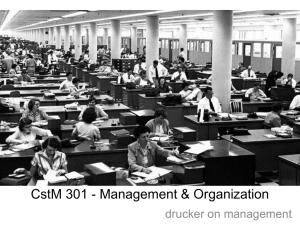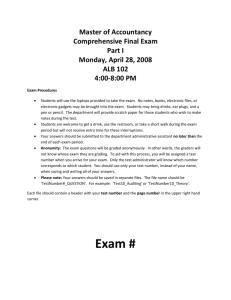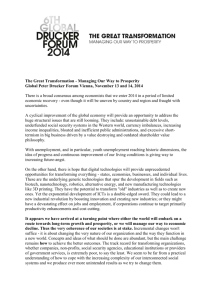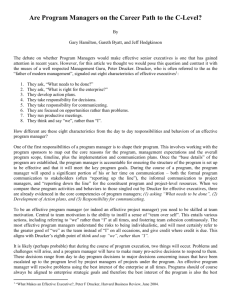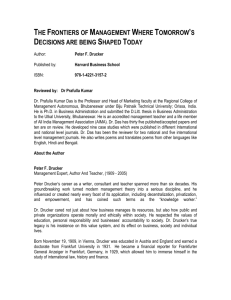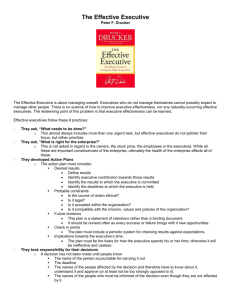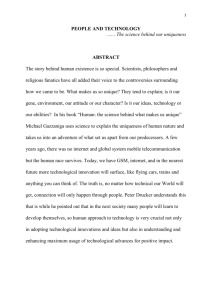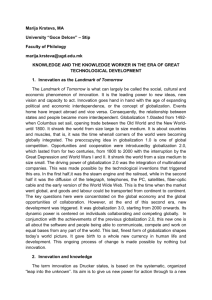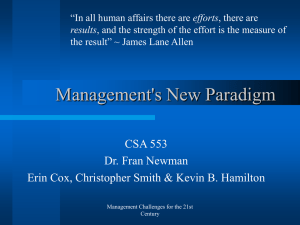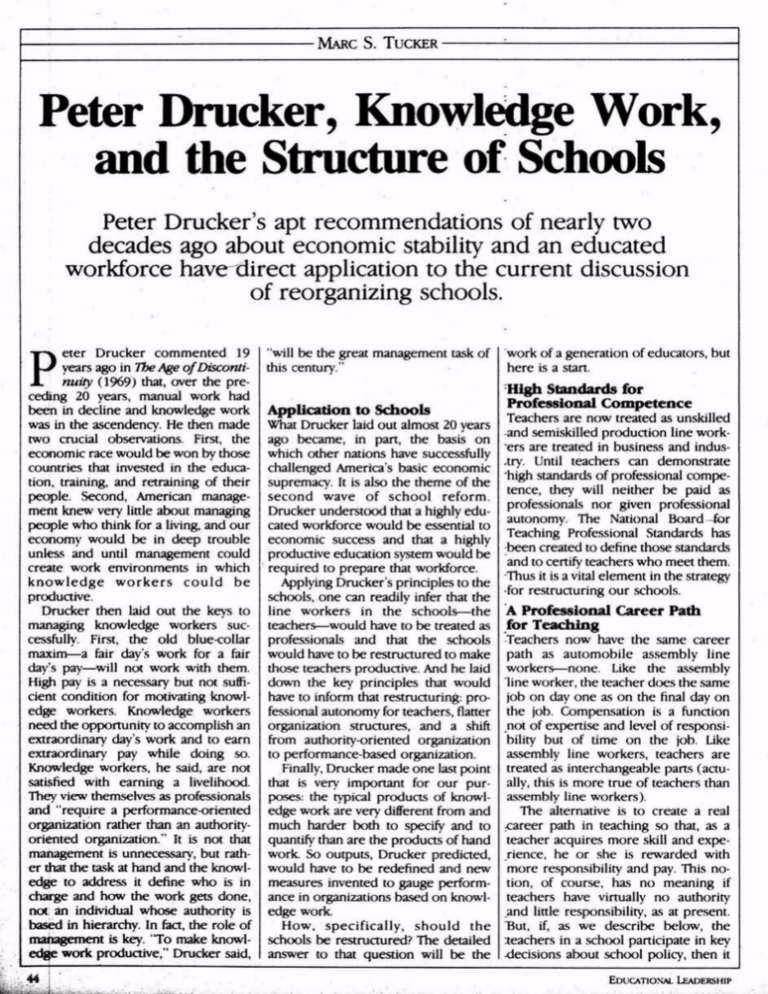
- MARC S. TUCKER
Peter Drucker, Knowledge Work,
and the Structure of Schools
Peter Drucker's apt recommendations of nearly two
decades ago about economic stability and an educated
workforce havedirect application to the current discussion
of reorganizing schools.
P
eter Drucker commented 19
years ago in The Age of Disconti
nuity ( 1969) that, over the pre
ceding 20 years, manual work had
been in decline and knowledge work
was in the ascendency. He then made
two crucial observations. First, the
economic race would be won by those
countries that invested in the educa
tion, training, and retraining of their
people. Second, American manage
ment knew very little about managing
people who think for a living, and our
economy would be in deep trouble
unless and until management could
create work environments in which
knowledge workers could be
productive.
Drucker then laid out the keys to
managing knowledge workers suc
cessfully. First, the old blue-collar
maxim—a fair days work for a fair
day's pay—will not work with them.
High pay is a necessary but not suffi
cient condition for motivating knowl
edge workers. Knowledge workers
need the opportunity to accomplish an
extraordinary day's work and to earn
extraordinary pay while doing so.
Knowledge workers, he said, are not
satisfied with earning a livelihood.
They view themselves as professionals
and "require a performance-oriented
organization rather than an authorityoriented organization." It is not that
management is unnecessary, but rath
er that the task at hand and the knowl
edge to address it define who is in
charge and how the work gets done,
not an individual whose authority is
based in hierarchy. In fact, the role of
management is key. 'To make knowl
edge work productive," Drucker said,
44
"will be the great management task of
this century."
work of a generation of educators, but
here is a start.
Application to Schools
High Standards for
Professional Competence
What Drucker laid out almost 20 years
ago became, in part, the basis on
which other nations have successfully
challenged America's basic economic
supremacy. It is also the theme of the
second wave of school reform.
Drucker understood that a highly edu
cated workforce would be essential to
economic success and that a highly
productive education system would be
required to prepare that workforce.
Applying Drucker's principles to the
schools, one can readily infer that the
line workers in the schools—the
teachers—would have to be treated as
professionals and that the schools
would have to be restructured to make
those teachers productive. And he laid
down the key principles that would
have to inform that restructuring: pro
fessional autonomy for teachers, flatter
organization structures, and a shift
from authority-oriented organization
to performance-based organization.
Finally, Drucker made one last point
that is very important for our pur
poses: the typical products of knowl
edge work are very different from and
much harder both to specify and to
quantify than are the products of hand
work. So outputs, Drucker predicted,
would have to be redefined and new
measures invented to gauge perform
ance in organizations based on knowl
edge work.
How, specifically, should the
schools be restructured? The detailed
answer to that question will be the
Teachers are now treated as unskilled
•and semiskilled production line work'ers are treated in business and indus.try. Until teachers can demonstrate
'high standards of professional compe
tence, they will neither be paid as
professionals nor given professional
autonomy. The National Board ^for
Teaching Professional Standards has
been created to define those standards
and to certify teachers who meet them.
•Thus it is a vital element in the strategy
•for restructuring our schools.
A Professional Career Path
for Teaching
Teachers now have the same career
path as automobile assembly line
workers—none. Like the assembly
'line worker, the teacher does the same
job on day one as on the final day on
the job. Compensation is a function
not of expertise and level of responsi
bility but of time on the job. Like
assembly line workers, teachers are
treated as interchangeable parts (actu
ally, this is more true of teachers than
assembly line workers).
The alternative is to create a real
^career path in teaching so that, as a
teacher acquires more skill and expe
rience, he or she is rewarded with
more responsibility and pay. This no
tion, of course, has no meaning if
teachers have virtually no authority
.and little responsibility, as at present.
But, if, as we describe below, the
•.teachers in a school participate in key
•decisions about school policy, then it
EDUCATIONAL LEADERSHIP
will make sense to involve the most
competent teachers more heavily in
these matters than the less competent,
just as senior partners in a law firm
have more to say about how the firm is
run than junior partners. It is also the
case, of course, that the senior people
in the law firm take on the most
difficult cases. Similarly, one would
expect that the most competent teach
ers would take on the most difficult
problems in the school.
Increasing skill and experience
would bring increasing responsibility
and with it increasing pay. In this way,
a career path in teaching would open,
with the potential of pay levels compa
rable to those in true professions. For
example, the contract recently negoti
ated in Rochester, New York, will en
able lead teachers, those at the top
level of responsibility in the system, to
earn yearly salaries of $70,000 without
leaving teaching.
One severe impediment to imple
menting plans of this sort has been
teachers' concerns about the criteria
used to determine who advances
along the career path. Rarely have they
believed that administrators would
make such decisions based on teach
ers' professional competence. The
Carnegie report proposed that certifi
cates to be issued by the National
Board for Professional Teaching Stan
dards, an organization dominated by
teachers themselves, be used as a pre
requisite for advancement. Other fac
tors, determined locally, would deter
mine which board-certified teachers
would actually be assigned senior re
sponsibilities. The Rochester contract
is written in such a way that board
certification can be used when it be
comes available; but until the board
starts certifying teachers, panels of ad
ministrators and teachers—with teach
ers in the majority—will make that
judgment.
School-Based Management
Transferring more responsibility to in
dividual schools does not imply turn
ing teachers into administrators or
adding yet another layer of bureaucra
cy to a system already far too bureau
FEBRUARY 1988
cratic. To the contrary, it is essential to
turn schools into organizations run by
people who operate as true profes
sional colleagues, not as collections of
supervisors and subordinates.
Many decisions now made at the
district level would be made at the
school level, and many resources now
located at the district level would be
assigned to the school level. Most deci
sions about curriculum, instructional
materials, teaching techniques, and
staff development needs would be
made by the staffs of individual
schools. Much of the budget for dis
trict-level activities would be distribut
ed to the schools, which would decide
how best to use the funds to meet
their objectives. Schools could decide
to purchase services, such as testing or
curriculum specialists, from the cen
tral district or from other sources.
Individual schools would also deter
mine their staffing needs and how to
fill them. Some might decide to rely
heavily on electronic technology for
the delivery of information that teach
ers would otherwise transmit through
conventional lectures, using the mon
ey saved to hire highly paid teachers
who are first-rate diagnosticians and
tutors. Another school might decide to
invest heavily in college students who
could tutor students in subjects not
requiring skilled teachers, thus pro
ducing a high ratio of adults to
students.
Each school would decide its own
professional growth needs, so that staff
development would be tightly inte
grated with the goals of the staff for
that school and would become a tool
that the professional staff could use to
implement their overall plan for that
school.
Many of the people who now oper
ate out of district offices would be
reassigned to individual schools, be
coming part of the team of people
with collective responsibility for that
school. The balkanization of the
schools, with each office in the district
responsible for some aspect of what
goes on in the schools, but no one in
control of the whole school program,
would come to an end. Using
Drucker's terms, control by authority
would be greatly reduced, largely re
placed by professional norms of per
formance, operating within the school
itself.
School Leadership
Effective school leadership is crucial to
the success of restructured schools.
Because many decisions now made at
the district level will be made at the
school level, there will be more issues
to decide within the school than ever
before. At the same time, it will be
essential to involve teachers fully in
making those decisions. For both
those reasons, school leaders will face
greater burdens than they have in the
past.
How should that leadership role be
structured? Certainly, one way is to
have a sort of cabinet or senior council
made up of the principal and the lead
teachers in the school. Another way is
for lead teachers as a group to take
responsibility for their school, with
one in the role of "managing teacher."
similar to the role of managing partner
in a professional firm. These two alter
natives may look precisely the same in
practice.
Still another approach, probably
most suitable in large schools, would
draw on the example of hospitals, in
which a sharp distinction is made be
tween medical policy and administra
tion. In this model, the school would
be run by a school administrator, who
would not be expected to be an in
structional leader; instructional lead
ership would come from the top
teacher in the school (the "principal
teacher"), operating in council with
other lead teachers, in much the way
that the top medical leadership in a
hospital comes from the chief of staff,
who is a doctor, rather than the hospi
tal administrator, who is not.
The point is not that any one of
these models is preferable to another,
but that we need to try variations of all
of them to determine which work best
under which circumstances.
District Leadership
Drucker's central challenge—how
45
best to manage knowledge workers
for maximum productivity—falls to
the school board and the superinten
dent. This is where the leadership
must come from for redesigning the
system, moving it from the manage
ment of people who are told what to
do to the management of people who
think for a living. This is the challenge
faced by almost every corporation in
America today.
Those companies that are succeed
ing—like IBM, 3M, and John Deere—
have learned to be clearer than ever
before about organizational goals, to
push decision-making authority down
to the front lines, to tie progress
against goals to the rewards of front
line workers, to reduce the layers of
management between the front line
and the front office, and to turn middle
management into champions and de
velopers of the most able talent on the
front line. In the schools, just as in
many industries, labor and manage
ment will have to learn how to work
together toward these ends.
Redefining Goals and Creating
New Measures
The primary goal of the school struc
tures created in the early part of this
century—the structure we have now—
was to help students acquire basic
skills. Schools were places where facts
were crammed into students and pro
cedures mastered. They still are.
The task ahead is very different. A
nation that thinks for a living needs
conceptual mastery of the core sub
jects, strong analytical skills, the ability
to communicate well, and all the other
things educators put in the category of
higher-order thinking ability. The pur
pose of restructuring our schools is to
create organizations capable of vastly
Meet the ongoing challenge of
computer-related change
Long-Range Planning for
Computers in Schools
Dr. Dave Moursund
Dr. Dick Ricketts
Major Sections
The Information Age, Computers and Education
Problem Solving and Strategic Planning
Generic Computer Education Goals
Advice on Computer Education Issues
For more information, send
your name and address to
Information Age Education
1250 East 29th Place
Eugene, OR 97403-1621
46
increasing students' higher-order
skills. That is why schools need to be
places where ideas have currency, why
they need to be staffed by people who
are comfortable with ideas, and why
they must be redesigned so that such
people can be as productive as
possible.
A major obstacle, which policymakers and educators must work to avoid,
is that the success of school restructur
ing efforts may be measured against
the old goal of basic skills achieve
ment with the old measures of normreferenced machine-scorable tests,
rather than against the appropriate
goals of progress on higher-order
skills. This is partly because policymakers and the public do not yet
understand why the old goals are inad
equate and the new goals necessary,
and partly because educators have not
yet figured out how to devise adequate
measures of performance on higherorder skills that can be economically
administered to large numbers of
students.
It is essential to solve this problem.
Drucker's point about goals and mea
surement is that the proper manage
ment of knowledge work requires ap
propriate ways to evaluate the
performance of knowledge workers.
The whole school restructuring effort
will surely fail if teachers and school
managements are judged by the
wrong goals, using the wrong mea
sures. Some states, districts, and re
search centers are making progress on
this score. Here as elsewhere, the full
dimensions of the restructuring agen
da are only now becoming apparent.O
Reference
Drucker, Peter F. The Age of Discontinuity:
Guidelines to Our Changing Society
: New York: Harper & Row, 1969.
Author's note: This article is based in
part on recommendations made in A Na
tion Prepared: Teachers for the 21st Centu
ry, released in 1986 by the Carnegie Forum
on Education and the Economy.
Marc S. Tucker is Executive Director of
the Carnegie Forum on Education and the
Economy, 1320 18th St., N.W., Washington,
DC 20036.
EDUCATIONAL LEADERSHIP
Copyright © 1988 by the Association for Supervision and Curriculum
Development. All rights reserved.

